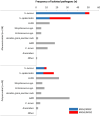The Microbiological Etiology of Fracture-Related Infection
- PMID: 35873162
- PMCID: PMC9300981
- DOI: 10.3389/fcimb.2022.934485
The Microbiological Etiology of Fracture-Related Infection
Abstract
Purpose: Fracture-related infection (FRI) is an important complication related to orthopaedic trauma. Although the scientific interest with respect to the diagnosis and treatment of FRI is increasing, data on the microbiological epidemiology remains limited. Therefore, the primary aim of this study was to evaluate the microbiological epidemiology related to FRI, including the association with clinical symptoms and antimicrobial susceptibility data. The secondary aim was to analyze whether there was a relationship between the time to onset of infection and the microbiological etiology of FRI.
Methods: FRI patients treated at the University Hospitals of Leuven, Belgium, between January 1st 2015 and November 24th 2019 were evaluated retrospectively. The microbiological etiology and antimicrobial susceptibility data were analyzed. Patients were classified as having an early (<2 weeks after implantation), delayed (2-10 weeks) or late-onset (> 10 weeks) FRI.
Results: One hundred ninety-one patients with 194 FRIs, most frequently involving the tibia (23.7%) and femur (18.6%), were included. Staphylococcus aureus was the most frequently isolated pathogen, regardless of time to onset (n=61; 31.4%), followed by S. epidermidis (n=50; 25.8%) and non-epidermidis coagulase-negative staphylococci (n=35; 18.0%). Polymicrobial infections (n=49; 25.3%), mainly involving Gram negative bacilli (GNB) (n=32; 65.3%), were less common than monomicrobial infections (n=138; 71.1%). Virulent pathogens in monomicrobial FRIs were more likely to cause pus or purulent discharge (n=45;54.9%; p=0.002) and fistulas (n=21;25.6%; p=0.030). Susceptibility to piperacillin/tazobactam for GNB was 75.9%. Vancomycin covered 100% of Gram positive cocci.
Conclusion: This study revealed that in early FRIs, polymicrobial infections and infections including Enterobacterales and enterococcal species were more frequent. A time-based FRI classification is not meaningful to estimate the microbiological epidemiology and cannot be used to guide empiric antibiotic therapy. Large multicenter prospective studies are necessary to gain more insight into the added value of (broad) empirical antibiotic therapy.
Keywords: antibiotic resistance; fracture; fracture-related infection; infection; microbiology.
Copyright © 2022 Depypere, Sliepen, Onsea, Debaveye, Govaert, IJpma, Zimmerli and Metsemakers.
Conflict of interest statement
The authors declare that the research was conducted in the absence of any commercial or financial relationships that could be construed as a potential conflict of interest.
Figures




Similar articles
-
The Microbiological Profile and Antibiotic Susceptibility of Fracture Related Infections in a Low Resource Setting Differ from High Resource Settings: A Cohort Study from Cameroon.Antibiotics (Basel). 2024 Mar 4;13(3):236. doi: 10.3390/antibiotics13030236. Antibiotics (Basel). 2024. PMID: 38534671 Free PMC article.
-
Causative Pathogens Do Not Differ between Early, Delayed or Late Fracture-Related Infections.Antibiotics (Basel). 2022 Jul 14;11(7):943. doi: 10.3390/antibiotics11070943. Antibiotics (Basel). 2022. PMID: 35884197 Free PMC article.
-
Comparative analysis of pathogen distribution in patients with fracture-related infection and periprosthetic joint infection: a retrospective study.BMC Musculoskelet Disord. 2023 Feb 13;24(1):123. doi: 10.1186/s12891-023-06210-6. BMC Musculoskelet Disord. 2023. PMID: 36782133 Free PMC article.
-
Literature review on the distribution characteristics and antimicrobial resistance of bacterial pathogens in neonatal sepsis.J Matern Fetal Neonatal Med. 2022 Mar;35(5):861-870. doi: 10.1080/14767058.2020.1732342. Epub 2020 Feb 26. J Matern Fetal Neonatal Med. 2022. PMID: 32102584 Review.
-
Multidrug-Resistant and Virulent Organisms Trauma Infections: Trauma Infectious Disease Outcomes Study Initiative.Mil Med. 2022 May 4;187(Suppl 2):42-51. doi: 10.1093/milmed/usab131. Mil Med. 2022. PMID: 35512375 Free PMC article. Review.
Cited by
-
Surgical and microbiological characteristics that influence the probability of reoperation to promote bone healing after fracture-related infection diagnosis.Eur J Orthop Surg Traumatol. 2025 Feb 24;35(1):74. doi: 10.1007/s00590-025-04202-x. Eur J Orthop Surg Traumatol. 2025. PMID: 39994017
-
Fracture-Related Infection of the Proximal Femur - Diagnostics and Treatment.Geriatr Orthop Surg Rehabil. 2025 Mar 26;16:21514593251324768. doi: 10.1177/21514593251324768. eCollection 2025. Geriatr Orthop Surg Rehabil. 2025. PMID: 40151577 Free PMC article. Review.
-
Vancomycin-based tracers guiding in situ visualization of bacteria on osteosynthesis devices and surgical debridement.Eur J Nucl Med Mol Imaging. 2025 Aug;52(10):3877-3890. doi: 10.1007/s00259-025-07249-4. Epub 2025 Apr 2. Eur J Nucl Med Mol Imaging. 2025. PMID: 40172692 Free PMC article.
-
Fracture-Related Infection-Epidemiology, Etiology, Diagnosis, Prevention, and Treatment.Dtsch Arztebl Int. 2024 Jan 12;121(1):17-24. doi: 10.3238/arztebl.m2023.0233. Dtsch Arztebl Int. 2024. PMID: 37970721 Free PMC article. Review.
-
A fluorogenic micrococcal nuclease-based probe for fast detection and optical imaging of Staphylococcus aureus in prosthetic joint and fracture-related infections.Eur J Nucl Med Mol Imaging. 2024 Aug;51(10):2988-2997. doi: 10.1007/s00259-023-06499-4. Epub 2023 Nov 14. Eur J Nucl Med Mol Imaging. 2024. PMID: 37962617 Free PMC article.
References
-
- Aboltins C. A., Dowsey M. M., Buising K. L., Peel T. N., Daffy J. R., Choong P. F., et al. . (2011). Gram-Negative Prosthetic Joint Infection Treated With Debridement, Prosthesis Retention and Antibiotic Regimens Including a Fluoroquinolone. Clin. Microbiol. Infect. 17 (6), 862–867. doi: 10.1111/j.1469-0691.2010.03361.x - DOI - PubMed
-
- Baertl S., Walter N., Engelstaedter U., Ehrenschwender M., Hitzenbichler F., Alt V., et al. . (2022). What Is the Most Effective Empirical Antibiotic Treatment for Early, Delayed, and Late Fracture-Related Infections? Antibiotics (Basel) 11 (3), 287. doi: 10.3390/antibiotics11030287 - DOI - PMC - PubMed
Publication types
MeSH terms
Substances
LinkOut - more resources
Full Text Sources

